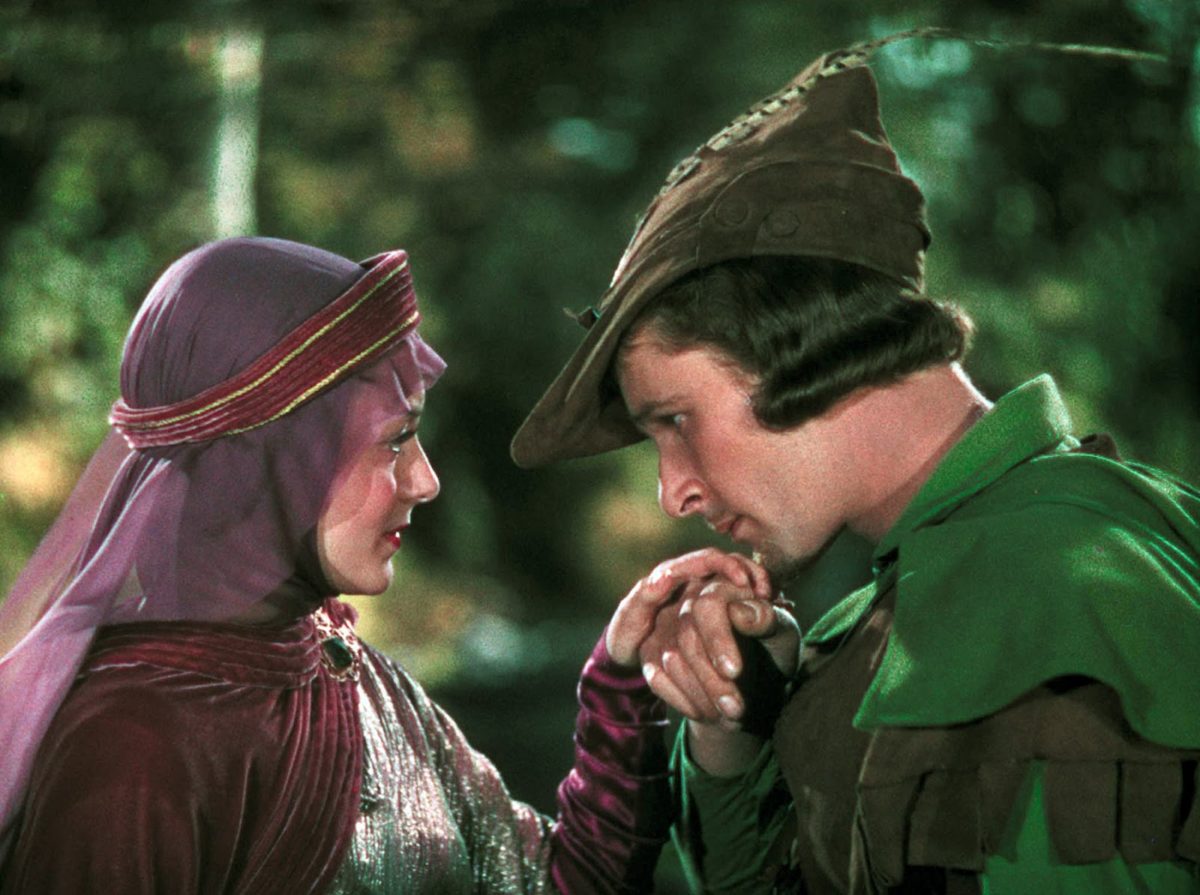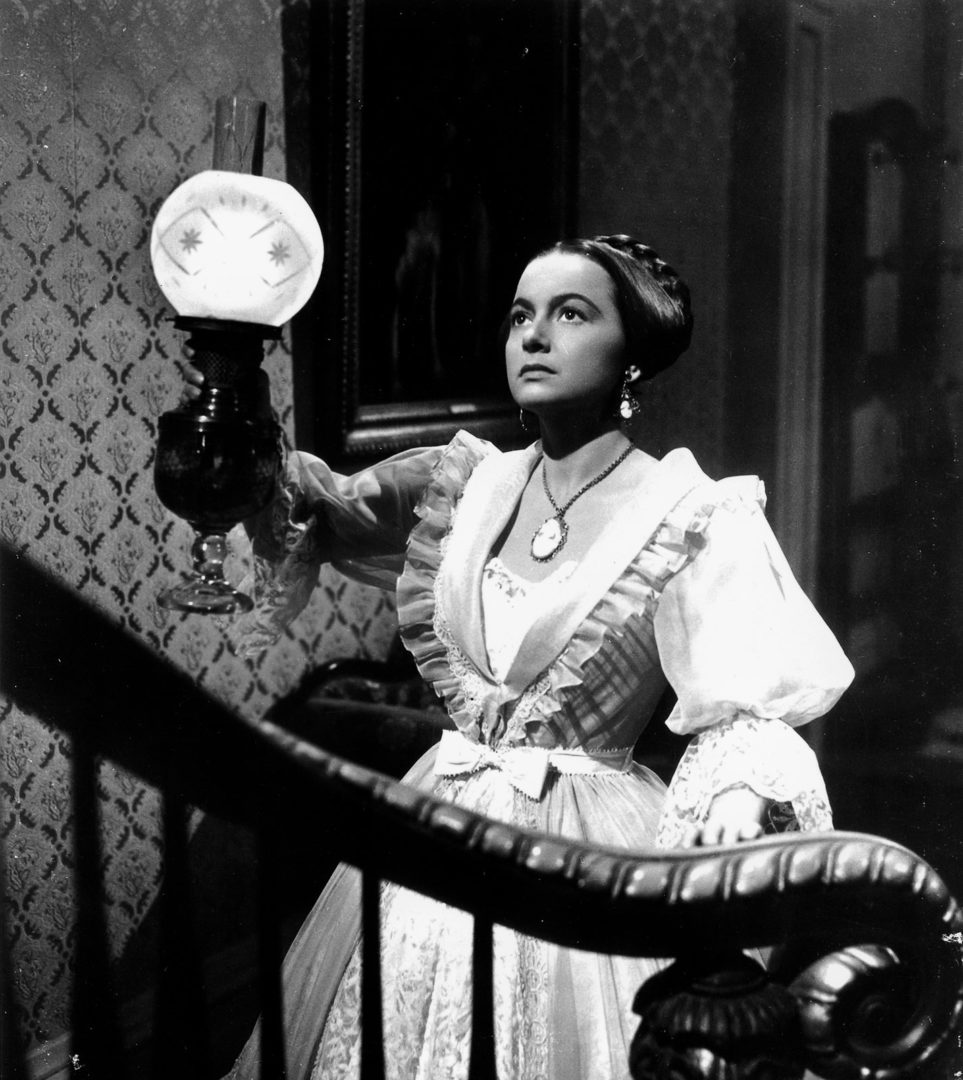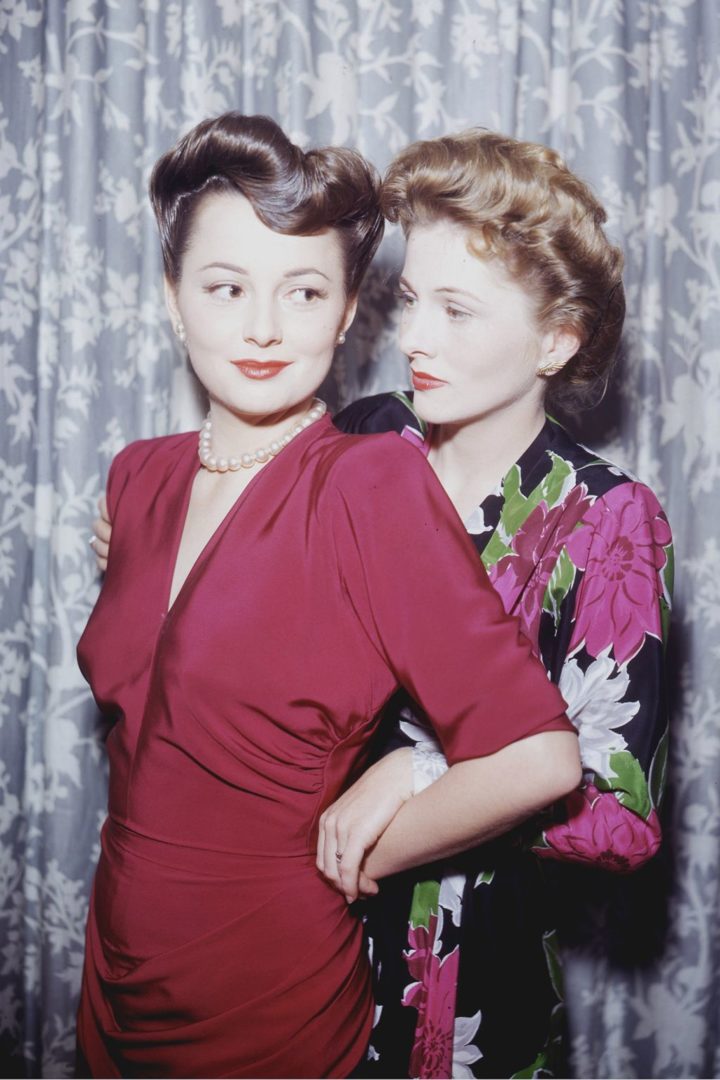The name ‘Olivia de Havilland’ has always been my favorite Hollywood name. ’Gustav von Seyffertitz’ comes in a close second. It is a very pleasant name to say out loud. If you try it, you’ll easily appreciate its particular cadence and poetic rhythm. It is a strong and confident name, but it turns more soft and gentle towards the end. It just perfectly suits its bearer, as Olivia de Havilland was a fighter but also a charmer; she could be tough and unrelenting but also gentle and cooperative (under the right circumstances). Just think it was her real birth name and not a stage name dreamed up for her by a film studio. For both Olivia and her sister Joan, who used her mother’s name Fontaine professionally, the studio marketing department did not even have to think up an exciting or exotic back story as they often had to do for emerging stars: both sisters were born in Japan, the daughters of a British diplomate and a mother who had once been an actress.
Olivia de Havilland was probably the final living monument of classical Hollywood. Like de Havilland, Kirk Douglas, who also died in 2020, was born in 1916, but he entered pictures much later, after the Second World War. Despite her age, she was not exactly a long-forgotten star, if only because the film that consolidated her stardom for posterity, Gone with the Wind (Victor Fleming 1939) was heavily critiqued (again) earlier this year by Twelve Years a Slave screenwriter John Ridley, who slammed the film’s romantic depiction of racist Old South values and its mellowing depiction of slavery. The film—adjusted for monetary inflation still the highest grossing to date—needed to be given an ‘explainer’ by eminent African American film scholar Jacqueline Stewart to keep it on HBO’s on-demand streaming platform. In a CNN op-ed, Stewart has pointed out that the film is indeed “a prime text for examining expressions of white supremacy in popular culture,” but also noted that the film invites multiple historical contexts to be considered, including a history of black performance strategies, even if these performances may seem hard to read or painful to watch now.
De Havilland herself had also been in the news relatively recently when she filed a complaint in 2017 concerning her portrayal in the television series Feud: Joan and Bette (FX). According to de Havilland’s lawyer the actress took issue with the fact that she was presented (by Catharine Zeta-Jones) as “a gossiper” and found that her “professional reputation for integrity, honesty, generosity, self-sacrifice and dignity” had been violated by the series’ depiction of her character. She lost this particular case, but she went down fighting, taking the case all the way to the Supreme Court.
But one day we all face the final fight. Miss de Havilland, “Livvy,” died on July 26, 2020. She was 104 years old.

A Star from Before the War
It is astonishing to realize that de Havilland was already an established star on the Warner Brothers’ roster when she was cast in David O. Selznick’s production of Gone with the Wind (MGM) in 1939. De Havilland had already been in pictures for four years then. She had come to Hollywood to be in Shakespeare (A Midsummer Night’s Dream) but would soon be used in all kinds of Warner fare, including comedies and especially romantic adventure stories. In the gargantuan Technicolor adaptation of Margaret Mitchell’s yarn on the old South and the Civil War, Vivien Leigh was cast as the feisty and hot-headed Scarlet, while de Havilland was cast as Melanie, who is sweet and meek (but not a sheep). De Havilland would point out later that playing a good girl was an art unto itself, and even her soft-spoken, angelic Melanie has a subdued roar inside of her. For Gone with the Wind she shared the screen with heartthrobs Clark Gable and Leslie Howard (an actor whose sex appeal has always eluded me) but at Warner Brothers she was most frequently paired with Errol Flynn, the most charming, mustachioed rascal to ever grace the screen, who aptly and sprightly titled his autobiography My Wicked, Wicked Ways. One of Flynn’s wicked ways, according to de Havilland, was to once put a dead snake in her stockings as a sign of his love and admiration.
On screen Flynn and de Havilland made a terrific pair. Flynn’s rakish characters loved to tease de Havilland’s, but she was always very clever and cute about being teased. Her films with Flynn are classic adventure stories with a romantic twist set at sea, in British colonial India, in old England or in the Wild West (Captain Blood; The Charge of the Light Brigade; The Adventures of Robin Hood; Dodge City respectively), but the range and complexity of the emotions she was required to mine for each picture was limited and repetitive. She knew she could do more, be more, but as was the custom with Warner Brothers at the time, if a star was successful in one particular role, they were likely to be playing variations on the same theme. Until they rebelled. This had happened to James Cagney and Bette Davis, and Olivia de Havilland was no exception. When these actors decided that the next project selected for them by the studio was just too weak or demeaning—and as such potentially harmful for their careers—they declined to work. But their refusal was put on the record as a ‘suspension’—which meant that an actor received no pay and was legally unable to work anywhere else—and the weeks or months in which the star stubbornly refused or politely begged for a different role were added to their seven-year contracts. Cagney and Davis had both had their cases tried in court, both had lost. De Havilland had started complaining, politely, after Gone with the Wind. She was given nice parts in decent movies such as The Strawberry Blonde (Raoul Walsh, 1941) and Hold Back the Dawn (Mitchell Leisen, 1942), but these were still supporting roles and she was always the male star’s ‘date’. (In The Strawberry Blonde she was not even the titular blonde, Rita Hayworth was!) She longed for more variation, for bigger parts—and of course, for top billing—and respect. She too started to decline parts, only to find out that to be the subject of Jack Warner’s rage could be quite unpleasant.
However, she proved herself a worthy and dignified opponent. Olivia de Havilland became the first actor to successfully renegotiate the terms of the seven-year contracts and to put a stop to the endless additions of suspension time. Still, her win came at a high price. During the legal battle she wasn’t able to make films (between 1944 and 1946), which vexed her greatly. On top of that, her legal bills were enormous and even after the first ruling was in her favor, Warner did not yield and appealed, leaving her unemployable for a long time. (No studio would hire a star who could at any time be summoned back to her ‘owners’.) It must have been an agonizing time for de Havilland, who was effectively banned from the screen for a long time. But she kept busy: she did some radio work—she did have a lovely voice, melodious and sweet with precise diction but never affected—and she took up patriotic work and visited soldiers in Alaska and the Pacific, which would prove to be crucial. These were the war years and most stars did their utmost to show their support for the war effort: they either served (like Clark Gable, Henry Fonda and James Stewart), they entertained troops at home and abroad (like Dietrich), they opened a Hollywood Canteen (Bette Davis and John Garfield’s big project) or sold war bonds (like the ill-fated Carole Lombard). De Havilland visited troops in Alaska and in the South Pacific, but her bosses at Warner Brothers regarded these acts as ‘non sub-ordinance’. Sight and Sound’s Farran Smith Nehme cites Otto Friedrich, who claims that Warner even went as far as to write to General Hap Arnold to demand that de Havilland would be denied the opportunity to entertain the troops while she was expected to show up for work. The notion that a studio would actively deny their employers to be good patriots may have done the trick (as J.E. Smyth suggests in her book Nobody’s Girl Friday) and de Havilland won the final appeal. The so-called ‘De Havilland decision’ ended suspensions and contract extensions and revisions beyond the actor’s control. Her court ruling made it possible for actors, like those facing extensions upon returning from active duty, to renegotiate the terms of their contracts.

Sunshine and Shadow
Melanie in Gone with the Wind; Roy in In This Our Life (John Huston, 1943), bullied by Bette Davis’ character; Jody in To each his own (Leisen, 1946), bullied by conservative society; Virginia in The Snake Pit (Litvak, 1948), traumatized by patriarchal demands and bullied by her head nurse; and Catherine in The Heiress (Wyler, 1949), humiliated by the men in her life: sweet, morally righteous and gentle characters with a tendency to be victimized were an important part but also just one facet of the de Havilland spectrum. When she was cast in Robert Aldrich’s Hush Hush Sweet Charlotte (1964), replacing Joan Crawford in the role of devious Miriam opposite her friend Bette Davis, she wasn’t exactly playing against type because she had played several dark or evil characters before. She had been a nasty Charlotte Brontë in Devotion (Curtis Bernhardt, 1946), the bad half of identical twins in The Dark Mirror (Robert Siodmak, 1946) and an ambiguous, probably murderous, character in My Cousin Rachel (Henry Koster, 1952). Always avoiding flat characterization, she played her ‘bad’ characters sweet and subdued, carefully refraining from melodramatic gesturing. While there is absolutely nothing wrong with the de Havilland/Flynn pictures—they are all breezy, funny and charming films and de Havilland is excellent in them—she only reached true artistic fulfillment with the more personal projects she fought for after she was released from Warner Brothers. Both The Snake Pit (Twentieth Century Fox) and The Heiress (Paramount) are outstanding pictures. The Heiress offered not just a great part for de Havilland, who gives a nuanced and fragile performance opposite Montgomery Clift, but is also a subtle and precise exercise in interior deep space mise-en-scène. The film, one of Wyler’s best, shows the transformation of the young Catherine from a mousy, wide-eyed and innocent romantic to a more prudent, hardened but independent spinster. Most of this transformation is reflected in de Havilland’s face, gestures and posture. The final shot of de Havilland walking up the stairs, leaving Clift’s banging on the front door unanswered, is as strong, ambiguous and heart-gutting as Barbara Stanwyck walking away from her daughter’s happiness in Stella Dallas (King Vidor, 1936). The casting of the decidedly pretty de Havilland as an ‘ugly and unattractive’ woman was a stretch, but de Havilland showed that ugliness, or rather the personal conviction of one’s own ugliness, could indeed be acted.
Another triumph was The Snake Pit—adapted from the semi-autobiographical novel by Mary Jane Ward—a bold and courageous depiction of mental fragility and mental care institutions. Despite the film’s rather naive Freudian plotting and patriarchal world view (“all women are happiest in their domestic roles”), it is a strong drama with de Havilland showing off her emotional intelligence and dramatic reach. She did extensive research for her part, visiting mental care hospitals and talking to psychiatrists, and worked hard to deglamorize and de-prettify her appearance—as she would for The Heiress.
It really is not hard to find strong de Havilland pictures in the 1940s but her film career became less prosperous in later years and her filmmaking slowed down as she increasingly focused on her family and the stage. Her move to Paris in 1953 even physically separated her from Hollywood, but she did show up for good parts in the well-received Light in the Piazza (Guy Green, 1962) opposite Rossano Brazzi, for the star-studded bomb Airport ’77 (Jerry Jameson, 1977) or to play the Dowager Empress Maria in a television adaptation of Anastasia in 1986.
She aged beautifully.

Feud: Joan and Olivia
The tensions between de Havilland and her sister Joan Fontaine are well-known. The exact nature of the arduous relationship between both ambitious women is impossible to fathom and it seems indelicate and perverse to start probing now. I don’t think the sisters’ cold war influenced their professional careers, and as such I have largely left out their strained relationship, but on a personal level it must have been very painful. An ‘explanation’ offered by the mansplaining, rather misogynist psychiatrist (played by Lew Ayres) in The Dark Mirror is depressing and reductive: Ayres’ character points out that there is “a natural strong rivalry between sisters”—he actually means among all women but with sisters it is even worse, especially when it comes to lovers. I’ll settle for de Havilland’s own explanation: “My sister was born a lion, and I was born a tiger, and in the laws of the jungle, they were never friends.”